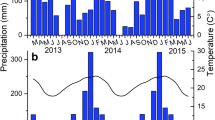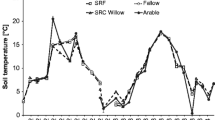Abstract
Reducing tillage intensity and diversifying crop rotations may improve the sustainability of irrigated crop** systems in semi-arid regions. The objective of this study was to compare the greenhouse gas (GHG) emissions, soil organic matter, and net global warming potential (net GWP) of a sugar beet (Beta vulgaris L.)-corn (Zea mays L,) rotation under conventional (CT) and reduced-tillage (RT) and a corn-dry bean (Phaseolus vulgaris L.) rotation under organic (OR) management during the third and fourth years of 4-year crop rotations. The gas and soil samples were collected during April 2011–March 2013, and were analyzed for carbon dioxide (CO2), methane (CH4), and nitrous oxide (N2O) emissions, water-filled pore space (WFPS), soil nitrate (NO3 −–N) and ammonium (NH4 +–N) concentrations, soil organic carbon (SOC) and total nitrogen (TN), and net global warming potential (net GWP). Soils under RT had 26% lower CO2 emissions compared to 10.2 kg C ha−1 day−1 and 43% lower N2O emissions compared to 17.5 g N ha−1 day−1 in CT during crop** season 2011, and no difference in CO2 and N2O emissions during crop** season 2012. The OR emitted 31% less N2O, but 74% more CO2 than CT during crop season 2011. The RT had 34% higher SOC content than CT (17.9 Mg ha−1) while OR was comparable with CT. Net GWP was negative for RT and OR and positive for CT. The RT and OR can increase SOC sequestration, mitigate GWP and thereby support in the development of sustainable crop** systems in semiarid agroecosystems.



Similar content being viewed by others
References
Baker JM, Ochsner TE, Venterea RT, Griffis TJ (2007) Tillage and soil carbon sequestration—what do we really know? Agric Ecosyst Environ 118:1–5
Bista P, Norton U, Ghimire R, Norton JB (2015) Greenhouse gas fluxes and soil carbon and nitrogen following single summer tillage event. Int J Plant Soil Sc 6:183–193
Black CA (1965) Methods of soil analysis. Part 1. Physical and mineralogical properties. American Society of Agronomy, Madison
Blake GR, Hartge KH (1986) Bulk density. In: Klute A (ed) Methods of soil analysis. Part 1. Physical and mineralogical methods. American Society of Agronomy and Soil Science Society of America, Madison, pp 363–375
Conservation Technology Information Center (CTIC) (2016) Tillage type definitions. http://www.ctic.purdue.edu/resourcedisplay/322/. Accessed 05 Aug 2016
Day PR (1965) Particle fraction and particle size analysis. In: Black CA, Evans DD, Ensminger LE, White JL, Clark FE (eds) Methods of soil analysis. Part I. Physical and mineralogicalproperties including statistics of measurement and sampling. American Society of Agronomy Inc., Madison, pp 545–566
Delate K, Cambardella CA (2004) Agroecosystem performance during transition to certified organic grain production. Agron J 96:1288–1298
Doane TA, Horwath WR (2003) Spectrophotometric determination of nitrate with a single reagent. Anal Lett 36:2713–2722
Drinkwater LE, Letourneau DK, Workneh F, Vanbruggen AHC, Shennan C (1995) Fundamental differences between conventional and organic tomato agroecosystems in california. Ecol Appl 5:1098–1112
Fierer N, Schimel JP, Holden PA (2003) Variation in microbial community composition through two soil depth profiles. Soil Biol Biochem 35:167–176
Ghimire R, Norton JB, Norton U, Ritten JP, Stahl PD, Krall JM (2013) Long-term farming systems research in the central high plains. Renew Agric Food Syst 28:183–193
Ghimire R, Norton JB, Stahl PD, Norton U (2014a) Soil microbiotic properties under irrigated organic and reduced-tillage crop and forage production systems. PLoS ONE. doi:10.1371/journal.pone.0103901
Ghimire R, Norton JB, Pendall E (2014b) Alfalfa-grass biomass, soil organic carbon, and total nitrogen under different management approaches in an irrigated agroecosystem. Plant Soil 374:173–184
Guzman J, Al-Kaisi M, Parkin T (2015) Greenhouse gas emissions dynamics as influenced by corn residue removal in continuous corn system. Soil Sci Soc Am J 79:612–625
Halvorson AD, Del Grosso SJ, Alluvione F (2010) Tillage and inorganic nitrogen source effects on nitrous oxide emissions from irrigated crop** systems. Soil Sci Soc Am J 74:436–445
Halvorson AD, Stewart CE, Del Grosso SJ (2016) Manure and inorganic nitrogen affect irrigated corn yields and soil properties. Agron J. doi:10.2134/agronj2015.0402
Hurisso TT, Norton U, Norton JB, Odhiambo J, Del Grosso S, Hergert GW, Lyon DJ (2016) Dryland soil greenhouse gases and yield-scaled emissions in no-till and organic winter wheat–fallow systems. Soil Sci Soc Am J 80:178–192
Hutchinson GL, Mosier AR (1981) Improved soil cover method for field measurement of nitrous oxide fluxes. Soil Sci Soc Am J 45:311–316
Intergovernmental Panel on Climate Change (IPCC) (2007) Climate change 2007. In: Metz B, Davidson OR, Bosch PR, Dave R, Meyer LA (eds) Working group III report. Mitigation of climate change. Cambridge University Press, Cambridge
Intergovernmental Panel on Climate Change (IPCC) (2014) The physical science basis. In: Stocker TF, Qin D, Plattner GK, Tignor M, Allen SK, Boschung J, Nauels A, **a Y, Bex V, Midgley PM (eds) Contribution of working group 1-5th assessment report of the intergovernmental panel on climate change. Cambridge University Press, Cambridge
Johnson JM, Archer D, Barbour N (2010) Greenhouse gas emission from contrasting management scenarios in the Northern Corn Belt. Soil Sci Soc Am J 74:396–406
Kong AYY, Fonte SJ, van Kessel C, Six J (2009) Transitioning from standard to minimum tillage: trade-offs between soil organic matter stabilization, nitrous oxide emissions, and N availability in irrigated crop** systems. Soil Tillage Res 104:256–262
Kravchenko AN, Robertson GP (2011) Whole-profile soil carbon stocks: the danger of assuming too much from analyses of too little. Soil Sci Soc Am J 75:235–240
Linn DM, Doran JW (1984) Effect of water-filled pore space on carbon dioxide and nitrous oxide production in tilled and nontilled soils. Soil Sci Soc Am J 48:1267–1272
Littell RC, Stroup WW, Freund RJ (2002) SAS for linear models. SAS Institute, Cary, p 466
Mosier AR, Halvorson AD, Reule CA, Liu XJ (2006) Net global warming potential and greenhouse gas intensity in irrigated crop** systems in northeastern Colorado. J Environ Qual 35:1584–1598
Ogle SM, Swan A, Paustian K (2005) No-till management impacts on crop productivity, carbon input and soil carbon sequestration. Agric Ecosyst Environ 149:37–49
Parkin TB (2008) Effect of sampling frequency on estimates of cumulative nitrous oxide emissions. J Environ Qual 37:1390–1395
Pattey E, Trzcinski MK, Desjardins RL (2005) Quantifying the reduction of greenhouse gas emissions as a result of composting dairy and beef cattle manure. Nutr Cycl Agroecosys 72:173–187
Paustian K, Lehmann J, Ogle S, Reay D, Robertson GP, Smith P (2016) Climate-smart soils. Nature 532:49–57
Peterson G, Halvorson AD, Havlin JL, Jones OR, Lyon DJ, Tanaka DL (1998) Reduced tillage and increasing crop** intensity in the Great Plains conserves soil C. Soil Tillage Res 47:207–218
Powlson D, Stirling CM, Jat ML, Gerard BG, Palm CA, Sanchez PA, Cassman KG (2014) Limited potential of no-till agriculture for climate change mitigation. Nat Clim Change 4:678–683
Reeves S, Wang W (2015) Optimum sampling time and frequency for measuring N2O emissions from a rain-fed cereal crop** system. Sci Total Environ 530:219–226
Robertson GP, Paul EA, Harwood RR (2000) Greenhouse gases in intensive agriculture: contributions of individual gases to the radiative forcing of the atmosphere. Science 289:1922–1925
Rochette P, Gregorich EG (1998) Dynamics of soil microbial biomass C, soluble organic C and CO2 evolution after three years of manure application. Can J Soil Sci 78:283–290
Rochette P, Janzen HH (2005) Towards a revised coefficient for estimating N2O emissions from legumes. Nutr Cycl Agroecosyst 73:171–179
Saenger A, Geisseler D, Ludwig B (2011) Effects of moisture and temperature on greenhouse gas emissions and C and N leaching losses in soil treated with biogas slurry. Biol Fertil Soil 47:249–259
Sainju UM, Stevens WB, Caesar-Tonthat T, Liebig MA (2012) Soil greenhouse gas emissions affected by irrigation, tillage, crop rotation, and nitrogen fertilization. J Environ Qual 41:1774–1786
Sherrod LA, Dunn G, Peterson GA, Kolberg RL (2002) Inorganic carbon analysis by modified pressure-calcimeter method. Soil Sci Soc Am J 66:299–305
Six J, Ogle SM, Breidt FJ, Conant RT, Mosier AR, Paustian K (2004) The potential to mitigate global warming with no-tillage management is only realized when practised in the long term. Glob Change Biol 10:155–160
Snyder CS, Bruulsema TW, Jensen TL, Fixen PE (2009) Review of greenhouse gas emissions from crop production systems and fertilizer management effects. Agric Ecosyst Environ 133:247–266
Soil Survey Staff (2015) Web Soil Survey. http://websoilsurvey.nrcs.usda.gov. Natural Resources Conservation. Service, United States Department of Agriculture. Accessed 27 Jan 2015
Thangarajan R, Bolan NS, Tian G, Naidu R, Kunhikrishnan A (2013) Role of organic amendment application on greenhouse gas emission from soil. Sci Total Environ 465:72–96
Thelen KD, Fronning BE, Kravchenko A, Min DH, Robertson GP (2010) Integrating livestock manure with a corn–soybean bioenergy crop** system improves short-term carbon sequestration rates and net global warming potential. Biomass Bioenergy 34:960–966
Thomas GW (1996) Soil pH and soil acidity. In: Sparks DL (ed) Methods of soil analysis Part 3: Chemical methods. ASA and SSSA, Madison, pp 475–490
USDA-NRCS (2006) Land Resource Regions and Major land Resource Areas of the United States, the Caribbean, and the Pacific Basin. Agriculture Handbook 296. U.S. Government Printing Office, Washington. http://soils.usda.gov/survey/geography/mlra/. Accessed 15 Feb 2015
USEPA (2015) U.S. Greenhouse Gas Inventory Report: 1990–2013. http://www3.epa.gov/climatechange/ ghgemissions/usinventoryreport.html. Assessed 8 Jan 2015
Weatherburn MW (1967) Phenol-hypochlorite reaction for determination of ammonia. Anal Chem 39:971–974
West TO, Marland G (2002) A synthesis of carbon sequestration, carbon emissions, and net carbon flux in agriculture: comparing tillage practices in the United States. Agric Ecosyst Environ 91:217–232
West TO, Post WM (2002) Soil organic carbon sequestration rates by tillage and crop rotation: a global data analysis. Soil Sci Soc Am J 66:1930–1946
Western Regional Climate Center (2015) Historical climate information. Desert Research Institute, Reno. http://www.wrcc.dri.edu/. Accessed 15 Feb 2015
Acknowledgements
Authors would like to thank Jenna Meeks and Pradeep Neupane for their assistance in field sampling and laboratory analyses; David Legg for help in statistical analyses and Hero Gollany for reviewing the earlier version of this manuscript. This project was supported by USDA NIFA Organic Transition Competitive Grant program (#2010-042-51106).
Author information
Authors and Affiliations
Corresponding author
Rights and permissions
About this article
Cite this article
Ghimire, R., Norton, U., Bista, P. et al. Soil organic matter, greenhouse gases and net global warming potential of irrigated conventional, reduced-tillage and organic crop** systems. Nutr Cycl Agroecosyst 107, 49–62 (2017). https://doi.org/10.1007/s10705-016-9811-0
Received:
Accepted:
Published:
Issue Date:
DOI: https://doi.org/10.1007/s10705-016-9811-0




